Extremadura |
|
|
|
| Übersicht – Contents: | |
Extremadura |
|
|
|
| Übersicht – Contents: | |
Flagge – Flag: |
|
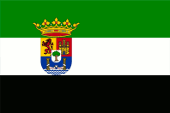 |
Flagge der Extremadura |
| historische und andere Flaggen – historical and other Flags: | |
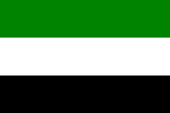 |
1977–1985, |
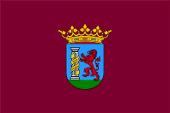 |
Flagge der Stadt Badajoz |
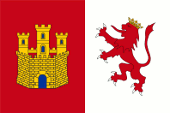 |
Flagge der Stadt Cáceres |
| Die Flagge der Extremadura wurde am 27.02.1985 offiziell eingeführt. Sie zeigt drei waagerechte Streifen in Grün, Weiß und Schwarz, und das Wappen des Landes in der Mitte des weißen Streifens, in Richtung Mast verschoben. Die Flagge kombiniert angeblich die Farben der Städte Cáceres (Grün-Weiß) und Badajoz (Weiß-Schwarz), aber deren Flaggen zeigen andere Farben. Unter der der Regierung des Generals Franco (1936–1975) waren alle regionalen Flaggen verboten. Nach Francos Tod (1975) wurden die regionalen Flaggen wieder eingeführt, bzw. neue geschaffen. Extremadura hatte vorher keine eigene Flagge, so dass im Jahre 1977 eine neue Flagge eingeführt wurde, wenn auch zunächst inoffiziell, da die Extremadura bis 1982 noch keinen Autonomiestatus hatte. Diese erste Flagge zeigte wie die heutige Flagge drei waagerechte Streifen in Grün, Weiß und Schwarz, jedoch noch kein Wappen. In den meisten autonomen Regionen Spaniens begann die neuere Flaggengeschichte bereits in den Jahren vor der Vergabe des Autonomiestatuts mit einer Flagge ohne Wappen, weil die Wappen oftmals noch gar nicht beschlossen waren. Immerhin hat sich meist durchgesetzt, dass die Flagge mit dem Wappen von den regionalen Behörden oder zu offiziellen Anlässen verwendet wird und die Flagge ohne Wappen quasi zu privaten, dekorativen Zwecken verwendet werden soll. |
The flag of Extremadura
was officially introduced on 27th of February in 1985. It shows three
horizontal stripes in green, white and black and the coat of arms of the
country in the middle of the white stripe, moved in direction of the pole.
The flag combines ostensibly the colours of the towns of Cáceres
(green-white) and Badajoz (white-black), but its flags show other colours.
Under the government of General Franco (1936–1975) all regional flags were forbidden. After the death of Franco (1975) the regional flags became re-introduced, respectively there were created new. Extremadura had in the times before none own flag, and they introduced the new flag in 1977, but it was unofficial, because Extremadura had none status of autonomy until 1982. That first flag showed like the today's flag three horizontal stripes in green, white and black, but still none coat of arms. In most autonomous regions of Spain, the more recent flag history already began in the years before the granting of the Statute of Autonomy with a flag without arms, because the arms had often not even been decided yet. After all, it has mostly become accepted that the flag with the coat of arms is used by the regional authorities or on official occasions and the flag without the coat of arms is to be used quasi for private, decorative purposes. |
| Quelle/Source: Wikipedia (ES), Flags of the World, Volker Preuß | |
Wappen – Coat of Arms: |
|
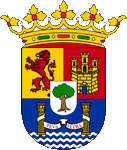 |
seit/since 1985, Wappen der Extremadura – coat of arms of Extremadura, Quelle/Source, nach/by: Wikipedia (ES) |
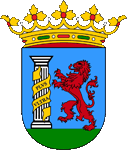 |
Wappen der Stadt Badajoz – coat of arms of Badajoz Town, Quelle/Source, nach/by: Wikipedia (ES) |
 |
Wappen der Stadt Cáceres – coat of arms of Cáceres Town, Quelle/Source, nach/by: Wikipedia (ES) |
| Das Wappen der Communidad Extremadura wurde offiziell am 03.06.1985 eingeführt. Es zeigt einen halbgespaltenen und geteilten Schild. Im ersten Feld einen roten Löwen auf Gold, im zweiten Feld eine goldene Burg auf Rot und im unteren dritten Feld vor einem blauen Hintergrund, unten weiße Wellenlinien, darüber zwei goldenen Säulen und ein silbernes Spruchband mit der Aufschrift "Plus Ultra". In der Mitte des Schildes ein kleiner silberner Herzschild mit einem Baum in Naturfarben. Oberhalb des Schildes die Krone Kastiliens. Das Wappen kombiniert Teile der Heraldik der Städte Badajoz und Cáceres, sowie Spaniens und der Extremadura selbst. Der rote Löwe ist dem Wappen von Badajoz entnommen und erinnert entfernt an den Löwen von Leon. Die Burg stammt aus dem Wappen von Cáceres und erinnert an Kastilien, zu der die Extremadura bis 1833 offiziell gehörte. Das untere dritte Feld zeigt Elemente der Heraldik Spaniens, und zwar "Säulen des Herkules" (eigentlich die beiden Felsspitzen zu beiden Seiten der Meerenge von Gibraltar) als Symbol des überseeischen Einflusses von Spanien, der nicht zuletzt darauf zurückzuführen ist, das sehr viele der Seefahrer und Eroberer aus der Extremadura stammen, unter anderem Hernán Cortés, Francisco Pizarro oder Hernando de Soto. Daher wird die Extremadura auch "Tierra de Conquistadores y Lusitanos" genannt. Auf dem Spruchband zwischen den Säulen das Motto des spanischen Staates: "Plus ultra" → "immer weiter". Es erinnert ebenfalls an die große seefahrerische und koloniale Vergangenheit Spaniens, aber auch der Extremadura. Der kleine silberne Herzschild mit der Balsa-Eiche steht wohl für die Extremadura selbst. Er soll einen der berühmten Eichenbäume darstellen, die für das Land so wichtig waren und noch immer sind, als Symbol des Lebens, Baumaterial und Lieferant des Futters für die wirtschaftlich bedeutende Viehzucht. |
The coat of arms of the
Communidad Extremadura was officially introduced on 3rd of June in 1985. It
shows a parted per fess and above in party per pale divided shield. In the
first field a red lion on gold, in the second field a golden castle on red
and in the lower third field in front of a blue background, below white wave
lines, above that two golden columns and a silvery banner with the
inscription "Plus Ultra". In the middle of the shield a small silvery heart
shield with a tree in natural colours. Above the shield the crown of
Castile. The coat of arms combines components of the heraldry of the cities
of Badajoz and Cáceres as well as of Spain and the Extremadura itself. The
red lion is taken from the coat of arms of Badajoz and remembers only a
little bit the lion of Leon. The castle is taken from the coat of arms of
Cáceres and remembers Castile, to which Extremadura officially belonged
until 1833. The lower third field shows elements of the heraldry of Spain,
namely the "Columns of Hercules" (actually the both rocks on both sides of
the Strait of Gibraltar) as symbol for the transoceanic influence of Spain,
which has its roots especially in the fact that very many of the seafarers
and conquerors come from the Extremadura, for instance Hernán Cortés,
Francisco Pizarro or Hernando de Soto. Because of that the Extremadura is
called also "Tierra de Conquistadores y Lusitanos". On the banner between
the columns the motto of the Spanish state: "Plus ultra" → "always further".
It remembers the great nautical and colonial history of Spain but of
Extremadura too. The small silvery heart shield with the balsa oak tree represents obviously Extremadura itself. It should represent one of the famous oak trees, which have been so important for the country and are important until nowadays, as symbol of live, construction material and purveyor of fodder for the economical important stock-farming. |
| Quelle/Source: Wikipedia (EN), Volker Preuß | |
|
Die autonomen Regionen Spaniens – The autonomous Regions of Spain: Interaktive Landkarte - interactive map |
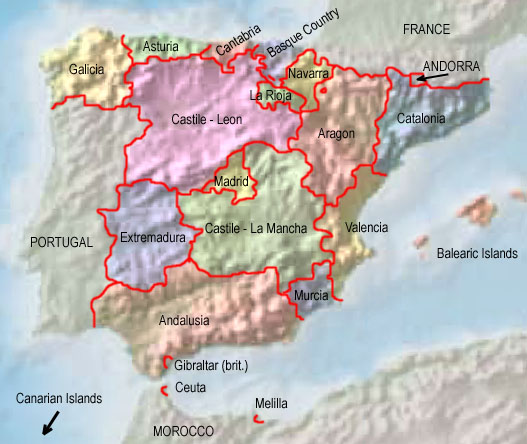 |
| Quelle/Source: Freeware, University of Texas Libraries, modyfied by: Volker Preuß |
| Zahlen und Fakten – Numbers and Facts: | |
|
|
|
|
|
|
|
|
|
|
|
|
|
|
|
Frühzeit
· Besiedlung durch Iberer ca. 600 v.Chr. · Einwanderung von Kelten, Vermischung mit den Iberern, Herausbildung der Keltiberer 218–201 v.Chr. · Zweiter Punischer Krieg, das Römische Reich erwirbt die Besitzungen Karthagos in Iberien, Unterwerfung der ganzen Iberischen Halbinsel bis zum Jahre 19 v.Chr., römische Besiedlung, Romanisierung, die heutige Estremadura kommt zur römischen Provinz Lusitania ca. 25 v.Chr. · die Römer gründen die Städte Augusta Emerita (heute Mérida) und Pax Augustas (heute Badajoz), Augusta Emerita (Mérida) bleibt bis zum Eindringen der Araber eine der bedeutendsten Städte der ganzen Iberischen Halbinsel ca. 400 n.Chr. · Völkerwanderung, Durchzug von Alanen, germanischen Sweben, Vandalen und Westgoten, die heutige Extremadura wird Teil des Westgotenreiches 711–714 · Vernichtung des Westgotenreichs durch von Nordafrika kommende Araber, die Westgoten ziehen sich nach Asturien und Kantabrien zurück, die heutige Extremadura wird von den Arabern besetzt, Gründung des Arabischen Emirates von Cordoba, Arabisierung, Moslemisierung, die Stadt Pax Augustas wird in "Baled Aix" umbenannt 929 · das Emirat von Cordoba wird zum Arabischen Kalifat Cordoba unter der Dynastie der Omajjaden umgebildet 1010 · Sturz der Omajjaden-Dynastie, bis 1040 zerfällt das Reich in mehrere arabische Königreiche (Malaga, Algeciras, Granada, Cordoba, Toldeo, Valencia, Zaragoza, Denia, Murcia und Badajoz) 1220–1250 · Truppen aus Kastilien und Leon befreien die Extremadura von den Arabern, das Land wird Krone von Kastilien untergeordnet 1229 · die Stadt Badajoz wird durch Alfons IX. von Leon und seinen Truppen von den Arabern befreit 1348 · die Pest entvölkert die Extremadura fast vollständig, das Land verödet 15.–16. Jahrhundert · im Zusammenhang mit einer gewissen wirtschaftlichen Erholung werden jedoch die einst mächtigen Eichenwälder für den Schiffbau abgeholzt, die ursprünglich sehr fruchtbare Landschaft trocknete aus und versteppte, große Teile der Bevölkerung wandern im 16. Jahrhundert nach Amerika aus 1833 · die bis dato in Spanien bestehenden Teilkönigreiche und Regionen werden in Provinzen aufgeteilt, auch Kastilien, so wurde wurde auch die Extremadura in zwei Provinzen unterteilt: Badajoz und Cáceres 16.08.1982 · die Extremadura erhält das Autonomiestatut innerhalb Spaniens (unter Zusammenfassung der Provinzen Badajoz und Cáceres), Gründung der "Autonomen Gemeinschaft Extremadura" |
|
early age
· settlement of Iberians ca. 600 B.C. · immigration of Celts, mix with the Iberians, evolution of the Celtiberians 218–201 B.C. · Second Punic War, the Roman Empire acquires the possessions of Carthago in Iberia, subjugation of whole Iberia until the year 19 B.C., Roman settlement, romanization, the today’s Extremadura comes to the Roman province of Lusitania ca. 25 B.C. · the Romans establish the Cities of Augusta Emerita (nowadays Mérida) and Pax Augustas (nowadays Badajoz), Augusta Emerita (Mérida) keeps until the invasion of the Arabs one of the most important towns on the whole Iberian Peninsula ca. 400 A.D. · Great Transmigration (Migration Period), immigration of Alans, teutonic Suebs, Vandals and Western Goth, the today’s Extremadura becomes a part of the Empire of the Western Goth 711–714 · annihilation of the Empire of the Western Goth by from northern Africa coming Arabs, the Western Goth retreat to Asturia and Cantabria, the south of the today's Extremadura becomes occupied by the Arabs, establishment of the Arabian Emirate of Cordoba, arabization, moslemization, the City of Pax Augustas becomes renamed in "Baled Aix" 929 · the Emirate of Cordoba becomes transformed ot the Arabian Califate of Cordoba under the dynasty of the Omajjads 1010 · overthrow of the Omajjads dynasty, to 1040 disintegrates the empire in some arabian kingdoms (Malaga, Algeciras, Granada, Cordoba, Toldeo, Valencia, Zaragoza, Denia, Murcia and Badajoz) 1220–1250 · troops from Castile and Leon liberate Extremadura from the Arabs, the country becomes subordinated under the Crown of Castile 1229 · Badajoz Town becomes liberated from the Arabs by Alfons IX. of Leon and his troops 1348 · the pestilence depopulates Extremadura nearly complete, the country desolates 15th–16th century · in context with a economical recovery however become the once mighty oak woods deforest for ship construction, the originally very fruitful landscape desiccates and became a steppe, big parts of the population emigrate to America in the 16th century 1833 · the until that point in time in Spain existing partial kingdoms and regions become divided in provinces, Castile too, in this way also Extremadura was divided in two provinces: Badajoz and Cáceres 16th of August in 1982 · Extremadura gets the statute of autonomy within Spain (by summary of the provinces of Badajoz and Cáceres), establishment of the "Autonomous Community of Extremadura" |
| Quelle/Source: Wikipedia (EN), World Statesmen, Volker Preuß |
| Der Name
"Extremadura" lässt sich mit "die Härteste" übersetzen. Er ist eine
Anspielung auf die Wetterextreme in dieser Gegend. Die Extremadura wird auch "Tierra de Conquistadores y Lusitanos" genannt, da sehr viele der Seefahrer und Eroberer der spanischen Geschichte aus der Extremadura stammen, unter anderem Hernán Cortés, Francisco Pizarro oder Hernando de Soto. Die Lusitaner sind ein mit den Kelten vermischtes und den Keltiberern ähnliches Volk im Gebiet der Extremadura und des heutigen Portugal, die in der Zeit des Römischen Reichs in der Provinz Lusitania lebten. |
The name
"Extremadura" is to translate with "the most hard". It is a hint to the
waether extremes in that region. Extremadura is also called "Tierra de Conquistadores y Lusitanos", because very many of the seafarers and conquerors in the Spanish history come from Extremadura, for instance Hernán Cortés, Francisco Pizarro or Hernando de Soto. The Lusitans are one with the Celts mixed people related to the Celtiberians in the area of Extremadura and the today's Portugal. In the times of the Roman Empire they lived in the province of Lusitania. |
| Quelle/Source: Handbuch der geographischen Namen, Volker Preuß | |